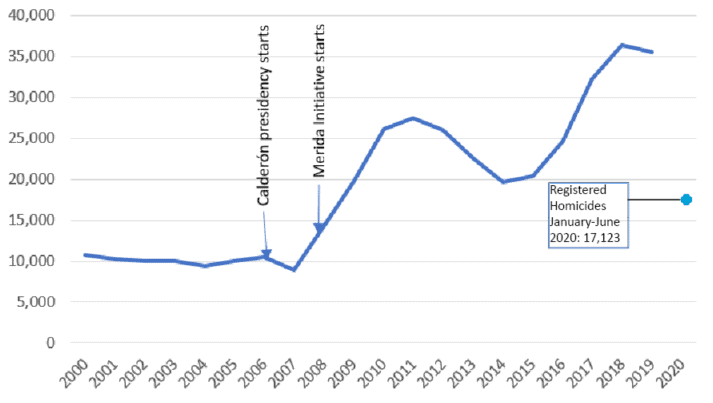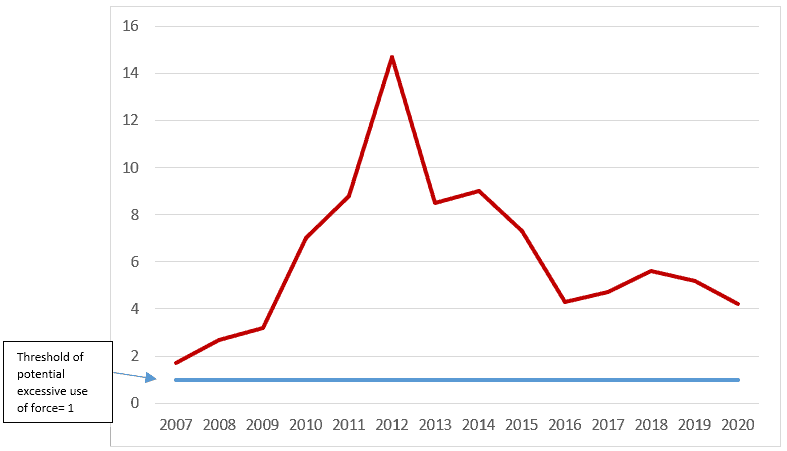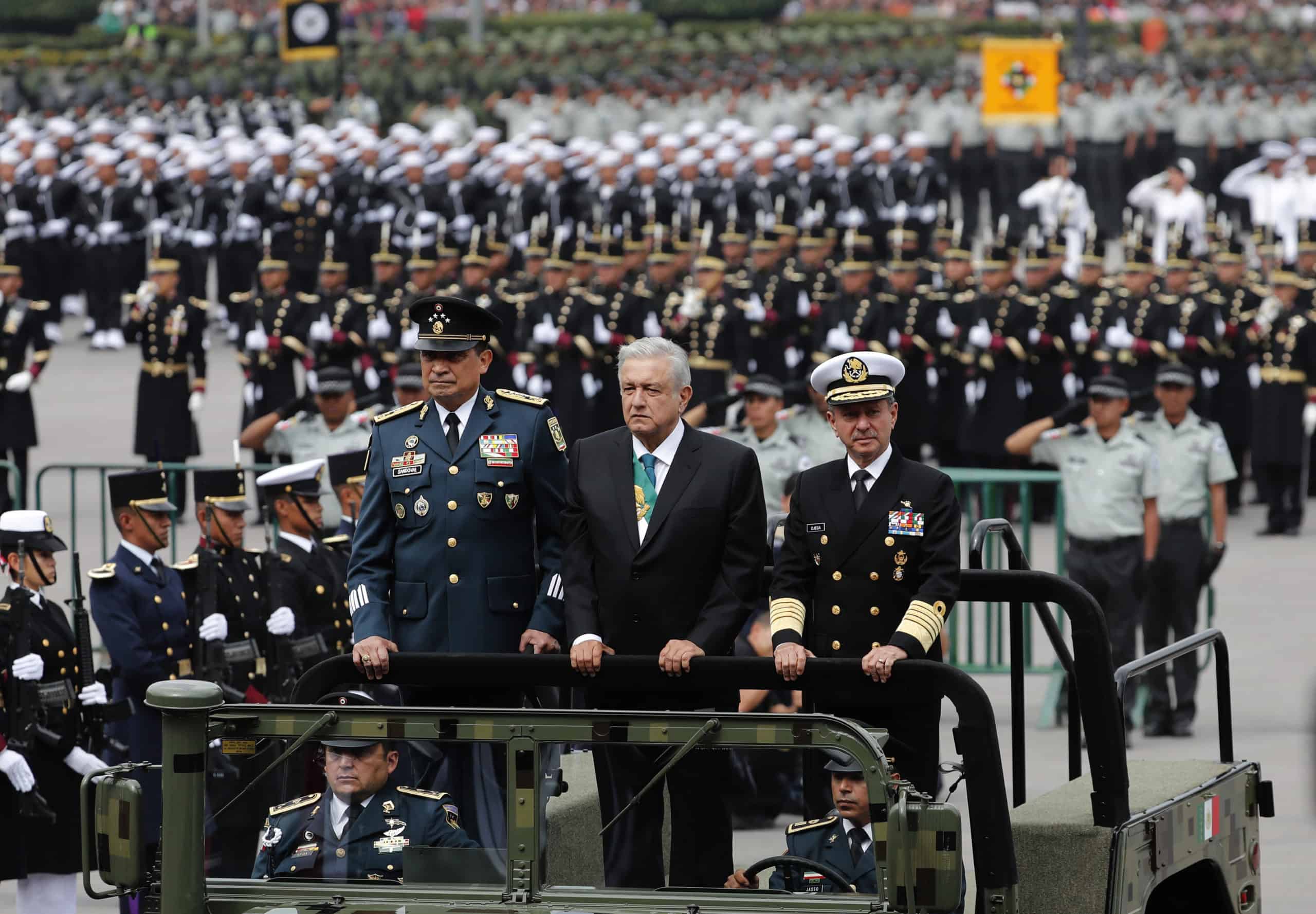Since the intensification of the war on crime in Mexico nearly fifteen years ago—characterized by the deployment of the armed forces and the targeting of drug kingpins—annual homicides have more than tripled. Since December 2006, Mexico has registered approximately 350,000 homicides and the government reports 85,000 disappeared and missing people.
In 2012, then-candidate Andrés Manuel López Obrador stated that, should he become president, he would take the military off the streets and leave a professionalized federal police force in its place. In 2016, he strongly criticized the war-on-crime model, declaring that coercive and militarized measures “don’t solve anything.” He reiterated in his successful 2018 campaign that he would redesign the country’s anti-violence strategy. As president, he has implemented social programs that, he believes, will address economic causes of insecurity.
However, López Obrador has failed to demilitarize public security; on the contrary, he has deepened various aspects of the militarized model. This month marks the one-year anniversary of López Obrador’s Presidential Agreement assigning a range of policing tasks to the armed forces until 2024. Likewise, this month marks the second anniversary of the law that created the National Guard, the new federal security force proposed by López Obrador. Despite forming part of the civilian Ministry of Security and Citizen Protection, the National Guard is a militarized force that operates under the coordination of the Ministry of Defense (Secretaría de la Defensa Nacional, SEDENA).
The sum of these two legal instruments is not encouraging: even if the armed forces withdraw from policing tasks by 2024, those tasks would remain in the hands of another militarized institution—the National Guard. Plans for necessary civilian police reform remain unclear in this context, as do strategies to address the multiple structural factors that drive violence in Mexico.
Militarization’s Failure to Curb Violence
Upon taking office in December 2006, President Felipe Calderón declared an all-out war on crime. Although military participation in policing and anti-drug tasks in Mexico was not new, the Calderón presidency ushered in the military’s current, central role in the anti-crime strategy. His government initiated a series of militarized security operations, leading to thousands of armed clashes involving military forces and tens of thousands of arrests by military troops.
Calderón also oversaw reforms to the country’s civilian policing structure; he stated that his long-term objective was for civilian authorities to take over public security tasks. However, those reforms did not bring about the level of change needed to achieve police effectiveness and accountability. In the end, militarization continued throughout the Calderón administration. President Enrique Peña Nieto would repeat, with some differences, the same cycle during his 2012-2018 presidency: having touted the creation of a new federal security force, the Gendarmerie, he ended up maintaining military deployment throughout his term. Under López Obrador, the territorial deployment of security forces includes an ever-growing contingent of National Guard (a force whose militarized nature will be analyzed below). As of today, the armed forces also continue to participate directly in security tasks. In short, despite some variations, militarization has morphed from a supposedly temporary measure into a long-term strategy.
As another component of the anti-crime model, successive Mexican administrations have targeted drug kingpins for arrest, a tactic in which Navy special forces (belonging to the Secretaría de Marina, SEMAR) have played a leading role with United States support. López Obrador has distanced himself from the kingpin strategy, although there have been examples of kingpin arrests during his time in office.
The results of the militarized war on crime have been catastrophic. Homicides increased dramatically from the Calderón presidency onwards (see figure 1). Arrests and killings of kingpins have fostered the fragmentation of criminal groups, leading to increased violence. Shoot-outs with security forces trigger increases in local homicide rates. The overwhelming majority of the tens of thousands of people the government reports as disappeared were taken in the past 15 years. A significant percentage of homicides and disappearances registered in recent years are concentrated in certain regions of the country, including several of Mexico’s most populous states.
- Homicides in Mexico 2000-June 2020

Source: National Statistics and Geography Institute 2000-2019, 2020
In the last two years, various analysts identify a reduction in federal security forces’ levels of frontal combat against criminal groups. Scaling back the use of warlike tactics that have increased violence without controlling insecurity can, in itself, be considered a positive step. However, this modification in the strategy has not been accompanied by appropriate and sufficient measures to address ongoing violence in the country. Today, a range of criminal groups continue to victimize the population, while homicides remain at record levels.
The foregoing confirms that authorities have not used these nearly 15 years of militarization to put in place sustainable and effective anti-violence measures at the national level. Instead of buying time for authorities to implement solutions, militarization has become the addiction that postpones those solutions indefinitely.
In this context, it is vital that Mexico’s authorities address the structural factors driving violence—starting with the State’s own role in violent phenomena. As exemplified in a series of high-profile cases over the last decade and a half, criminal groups routinely benefit from the tolerance or participation of State actors. The power exercised at different levels by criminal networks today can be understood only in light of this reality, whose consequences include a lack of effective investigation of both regional and local patterns of violence (which go well beyond the activities of transnational cartels).
An effective security model also requires prioritizing the true reform and professionalization of civilian police institutions, breaking the cycle of militarizing indefinitely as a failed response to police corruption and local forces’ lack of capacity. Achieving this requires overcoming once and for all the historic lack of commitment to police reform at all three levels of government.
The López Obrador administration has presented the National Police and Civic Justice Model with the aim of strengthening the role of state and municipal police in preventing and investigating crimes, among other goals. Progress in the implementation of the model—and, more importantly, its initial results in daily life—will shed light on the depth of this initiative’s potential impact on police institutions and practices. Up until now, however, the creation of the National Guard has been a much more visible priority than police reform.
|
The Merida Initiative Following months of dialogue with the Calderón administration, in October 2007 then-U.S. President George W. Bush announced a new regional security, rule of law, and anti-drug assistance package: the Merida Initiative. On June 30, 2008, Bush signed legislation authorizing the first round of assistance. By March 2010, Congress had approved more than $1.3 billion for Mexico through the Merida Initiative (a considerable increase in security cooperation), largely to purchase equipment, helicopters, vehicles, and technology, as well as to finance training. Under the administration of President Barack Obama, the United States modified the Merida Initiative to focus on “four pillars” of cooperation, namely:
Under the four pillars, Merida Initiative cooperation over the past decade has financed projects aiming to strengthen and professionalize security and justice institutions, facilitate the transition to the new criminal justice system, combat corruption, and promote human rights, among others. To date, Congress has approved more than $3 billion under the Merida Initiative. The U.S. Department of Defense (DOD) provides assistance to Mexico outside the framework of the Merida Initiative. In fiscal year 2019, Mexico received some $55.3 million in DOD assistance. Although significant, this level of funding does not reach the levels of military assistance seen during the Calderón administration. |
Militarization and Serious Human Rights Violations
Mexico’s militarized war on crime triggered high levels of serious human rights violations. Enforced disappearances committed by the army, the navy, and other security forces at all levels soon became one of the most high-profile expressions of this human rights crisis.
Another widely documented pattern has been the arbitrary detention and torture of civilians, including the torture of innocent people subsequently charged for crimes they did not commit. Although torture was already widespread before the Calderón administration, militarization and the war-on-crime model were important aggravating factors in its commission. According to an analysis by the World Justice Project based on data from the 2016 National Survey of People Deprived of Liberty, 88% of people detained by the navy and 85% of people detained by the army from 2006-2016 reported torture or ill-treatment. According to the same official survey, 41% of women detained by the navy, 21% of women detained by the army, and 10%-13% of women detained by police forces reported having survived rape in the context of the detention.
Finally, there are numerous documented cases of the armed forces killing civilians who posed no imminent threat and/or who were not participating in any crime, thus constituting extrajudicial or arbitrary executions. The perpetrators have repeatedly altered the scenes of these crimes. In a 2010 example, soldiers arbitrarily killed two students from the Monterrey Institute of Technology and planted weapons on the victims. Another example of scene alteration is the 2014 Tlatlaya case, in which it was also revealed that the soldiers responsible for killing a group of civilians had been operating under orders to “take out criminals” during nighttime hours.
During the current federal administration, cases such as the encounter that left one soldier and 14 civilians dead in Tepochica, Guerrero and the killing of a young couple in Carbó, Sonora have raised renewed concerns of arbitrary use of lethal force. In July 2020, part of an extrajudicial execution committed by soldiers was captured on video in Nuevo Laredo, Tamaulipas—one of a series of civilian deaths at the hands of soldiers in that city over the past two years, according to documentation by the non-governmental Nuevo Laredo Human Rights Committee. In March 2021, the dangers of militarizing Mexico’s southern border were illustrated by the arbitrary killing of a Guatemalan citizen by a soldier in Mazapa de Madero, Chiapas.
An internationally recognized indicator of potential extrajudicial executions is the lethality index, a measure that compares the number of civilians killed versus injured by a given security force in combat scenarios. In armed conflict, normally the injured outnumber those killed. That is, a “normal” lethality index would be 1 or less. In Mexico, the lethality index of the armed forces, according to data presented in December 2020 by López Obrador, is far above that level (see figure 2). Neither the current number of civilians killed nor the current lethality index reach the extreme levels of prior administrations. However, the armed forces continue to kill four or five civilians for each one they injure; that is, the lethality index today is over 400% of the expected level.
- Armed Forces’ Lethality Index 2007-Sept. 2020

Source: Presidential conference
Equally disproportionate is the number of civilians versus military personnel killed. Official SEDENA data obtained by the organization Intersecta show that in 2020, soldiers killed 237 civilians, while 6 soldiers died in these same encounters. Of the civilians killed, 71% died in “perfect lethality events” in which civilian deaths were the only result of the encounter between civilians and SEDENA.
Serious violations committed by authorities, coupled with militarization’s failure to curb violence, have led many actors to call on successive administrations to demilitarize and transform the country’s security model. Both human rights organizations and families who have experienced firsthand serious military abuses or the criminal violence unleashed by the war on crime have demanded an end to State violence and a change in strategy.
|
The War on Drugs: A Failed Regional Model Independently of the significant challenges within Mexico’s law enforcement and investigative institutions, drug policies adopted in both Mexico and the United States—and promoted across the hemisphere—pose obstacles to reducing violence. In particular, the prohibition and criminalization of drugs increase both the profitability of drug trafficking and the corruption associated with it. (It also bears recalling that guns smuggled from or through the United States contribute to criminal violence, including in furtherance of drug trafficking to the United States.) The evidence accumulated over the last 15 years in Mexico shows the devastating consequences of reacting to the phenomenon of drug use with warlike strategies. The drug war model has also failed to prevent or reduce the overdose crisis in the United States, which continues to increase. The basis of any bilateral or regional strategy to address the problematic use of psychoactive substances must be the recognition that the drug war, focused on the criminalization, eradication, and interdiction of substances, has been lost. Governments should instead address drug use from a perspective of public health, harm reduction, and regulation of legal markets, preventing drug consumption from generating exorbitant profits for violent criminal groups. |
The National Guard: A New Militarized Force
According to the Presidential Agreement issued by López Obrador one year ago, military participation in federal policing tasks will end by 2024. From then on, these tasks will fall exclusively to the National Guard (Guardia Nacional, GN), the new federal security force created in 2019. However, available information suggests that this planned transition, if it occurs, will be more of a change in name than a shift in strategy.
In theory, the GN is a civilian body: it is formally part of the Ministry of Security and Citizen Protection. However, it has a fundamentally military structure and institutional identity: the majority of its roughly 100,000 members are military troops, it is deployed throughout the country in barracks, and its Commander is a military general—one who went from active to retired status while leading the GN. Further, official documents published by the media—whose contents have not been denied by the government—reveal that SEDENA assumed operational control of the GN as of October 6, 2020.
The GN’s military character caused human rights concerns from the outset. Members of the GN have been implicated in alleged arbitrary executions in 2020 and 2021; in 2021, the GN has asked victims’ relatives to accept monetary compensation for the loss of their family members in exchange for not pushing for an investigation of the facts. The National Human Rights Commission has received roughly the same number of complaints against the GN as against SEDENA since 2020. In the first three months of 2021, the GN and SEDENA were the federal institutions driving the most complaints of ill-treatment, among other human rights violations, with each institution averaging more than one complaint daily.
Thus far, the Mexican government has failed to establish adequate control mechanisms for the GN. This issue is the subject of an order by the Inter-American Court of Human Rights (IACtHR), which, in its 2018 judgment in the Atenco case, ordered the creation of an observatory to monitor and improve accountability mechanisms and controls on the use of force by the Federal Police. Today this obligation applies to the National Guard, but the federal government has indicated to the IACtHR that it sees no need to comply with the Court’s order.
From Militarization to Militarism: The Growing Role of the Armed Forces in the Government
Historically, the Mexican armed forces have maintained a notable degree of autonomy, and their leading role in the public security strategy has further expanded their influence. López Obrador’s positions as a candidate had suggested that his presidency would mean a reconfiguration of this latter aspect of military power. However, after meeting with military leadership, the new president not only solidified the role of the armed forces as a pillar of the security strategy, but also began assigning them additional responsibilities.
For instance, recently enacted reforms charge SEMAR with the administration and control of the country’s ports. SEMAR and SEDENA have also assumed a growing role in customs control. The foregoing is in addition to the continuation or expansion of roles that the armed forces already played in prior administrations, such as immigration control.
Although the armed forces had participated in public works projects in the past, their role in the current government’s flagship infrastructure projects is striking. SEDENA is building hundreds of branches of the Bank of Well-Being—a channel for the delivery of social program benefits from the federal government. SEDENA is also building and, according to announcements by López Obrador, will run various airports. In a similar vein, SEDENA is building and will manage the Mayan Train, López Obrador’s priority tourism megaproject. The government has stated that the army will own and directly receive the profits generated by the project. For López Obrador, giving the Mayan Train to SEDENA will guarantee that the project cannot be privatized in the future “no matter who is in the government.” For the same reason, López Obrador announced that another megaproject, the Interoceanic Corridor, would be given to the navy and four state governments
|
Some Current Tasks of the Mexican Armed Forces (List includes functions in place since before the López Obrador administration as well as new activities.)
|
In any country in Latin America—a region whose history has been marked by coups and military dictatorships—the delegation of civilian tasks to the armed forces raises red flags. Several recent examples of different militaries’ roles in the hemisphere raise valid concerns about civil-military relations today.
Mexico’s experience has differed from that of other countries: throughout the wave of dictatorships in the region, Mexico suffered no military coups. However, the influence of Mexico’s armed forces within and beyond the security sphere may mean that a coup is not necessary in order for them to wield levels of power that, while falling short of a military government, hardly speak of a healthy democracy. With public security and flagship government projects in military hands, it is worth questioning what degree of power the civilian government retains over the military.
A recent case that exemplifies these concerns is that of Mexico’s former Defense Minister, General Salvador Cienfuegos, arrested in the United States in 2020 on charges of collusion with a criminal organization. Through unprecedented efforts, López Obrador achieved Cienfuegos’ return to Mexico. The National Prosecutor’s Office (Fiscalía General de la República, FGR) subsequently closed the investigation against Cienfuegos, without clearing up a series of potential crimes referenced in the chat messages that constituted the U.S. Department of Justice’s main evidence in the case (which López Obrador’s government also published online). The FGR’s central argument for closing the investigation was that Cienfuegos was not the person who wrote a series of incriminating messages. However, even the chats’ participants posited that Cienfuegos was not the one physically writing the messages; much less does this argument explain the FGR’s failure to investigate thoroughly the chats’ numerous references to collusion between criminal actors and authorities ranging from military officials to governors. In a further reaction to the case, López Obrador proposed, and Mexico’s Congress approved, a reform that has hampered the flow of intelligence between the United States and Mexico. In short, the president, the FGR, and the Mexican Congress subordinated other interests—from criminal justice to foreign relations—to the need to reject accusations against a figure who retains influence within the armed forces.
It seems unlikely that militarism in Mexico will diminish in the near future, given that López Obrador sees the armed forces’ participation in government tasks as a strategy to fight corruption. In reality, no institution is incorruptible, including the military; rather, without adequate control mechanisms, engagement in activities that present opportunities or requests for corruption increases the risk of it occurring in any institution. Leaving that aside, however, if López Obrador views the armed forces as the way to reduce corruption and guarantee efficiency in civilian tasks such as those listed above, then there is no reason not to expect him to apply the same logic to an indefinite list of other civilian functions.
Conclusions
In the war on crime, Mexico’s population has sustained the greatest losses. The militarized model has increased violence without furthering effective security strategies.
As WOLA and other organizations and experts have emphasized on numerous occasions over the past 15 years, no deployment of security forces will be sufficient to reverse violence as long as authorities are among criminal networks’ accomplices; as long as civilian police reform lacks commitment; as long as the country’s institutions do not make significant progress in investigating criminal phenomena; and as long as institutions charged with consolidating the rule of law tolerate human rights violations.
Addressing these factors—ensuring a constant focus on protecting the population—should be at the heart of Mexico’s anti-violence strategy. Such a strategy requires political will and close follow-up to take hold at the national level. What is concerning is that the government seems instead to be opting for a deepening and indefinite dependence on the armed forces.




